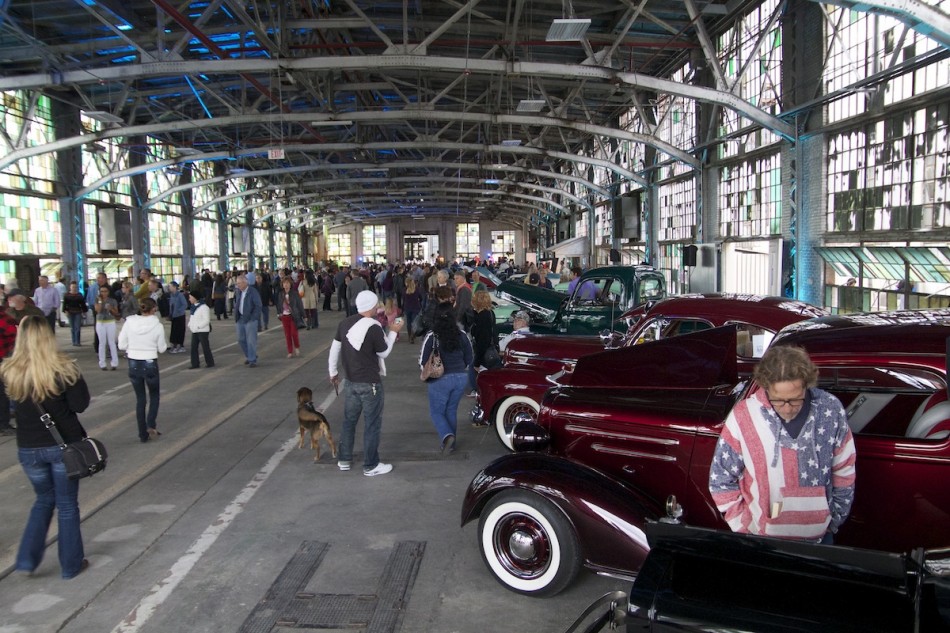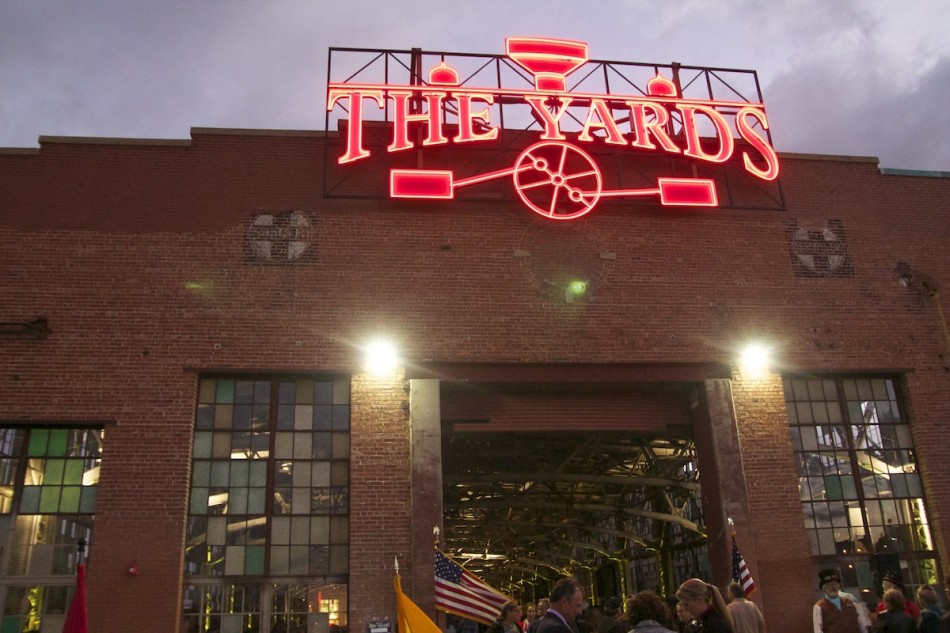
The Blacksmith shop will be hosting a pop-up market Sundays between May and October.
An Economic Cultural Engine in Albuquerque’s Rail Yards
The sprawling industrial holdover in the heart of Albuquerque remains a 27-acre question.
The former Atchison, Topeka and Santa Fe Railway complex has appeared in blockbusters like The Avengers and Terminator Salvation, standing in as a symbol of apocalyptic burnout.
The vast structures, the checkerboard of broken and unbroken windows, the grid of steel beams—they’ve also featured prominently in many a local high school student’s Photo I portfolio.
It’s testament to a machine age gone by and—as much as the pink Sandias or wide sky dotted with nostalgic flying machines—a visual symbol of Albuquerque. Despite the appeal, the yards have been at the mercy of the elements and urban explorers for decades.
Developers, neighbors, city-planners and Burqueños are eyeing the property, imagining what those 18 buildings can house, what opportunities they present—and who will benefit.
Architect Bruce Davis lives catty-corner to the site’s entrance. He deftly draws a map of the region, showing proposed Rail Yard features that have been considered and then axed over the years, and elements that still could become real. After all of the back-and-forth, he says, the start of this project is finally within sight. “I would like to see a lot of growth from the bottom up,” he says. “Although that’s typically not how developments happen these days, that’s how most of the really interesting things in the past have happened.”
One day, there will again be a use for the entire unknown stretch of Albuquerque yawning between the Barelas and South Broadway neighborhoods. But in the very near future, the beginnings of concerts, events and a weekly market are taking shape in one small part of it.

The Yards will host a pop-up market Sundays between May and October.
The Season

Chatter’s concert at Albuquerque’s Railyards will occur on May 3 from 5-6:30.
Twenty-four string instruments, a piano and a harpsichord will resound in the 23,000-square-foot Blacksmith Shop on Saturday, May 3. The Chatter concert will feature music by J.S. Bach, Alfred Schnitke and Arvo Part amid an exhibit of Rail Yards photo etchings by Eric Thelander.
Bree Ortiz, the city’s events and operations manager, says the space will be open for rental within the next week or so. (Call 505-768-3452 for information.) “The variety of events I’m getting calls for and the amount of people who are calling—the community is just really excited to have access to the space after it being empty for so long,” she says. “No one’s been allowed into it, so the intrigue … .”
Besides tours and the odd one-off special event, the yard has been closed since the ’70s, Ortiz says. Though the Blacksmith Shop has been upgraded with electricity, lights and a fire suppression system, it’s the only building that’s safe for visitors, she says, so the rest of the property won’t be accessible to the public. There is not yet any heating or cooling in the building. “That’s part of the space, too. You’re not at a hotel. You’re not at a casino. You’re sort of out there in the dirt of it.”
The Blacksmith Shop does not make any proceeds, so rentals are affordable, Ortiz says. “The little bit that we do get just goes to help pay the bills for the space.”
Two more examples of the variety Ortiz speaks of: Jackson’s famed mix-martial arts gym will be hosting fights in the Rail Yard on Saturday, May 10. And the New Mexico Brewers Guild will throw a craft beer fest on Saturday, June 21.

The Blacksmith Shop will be accepting rental reservations soon, according to Bree Ortiz
The Market
More than two dozen people from a variety of backgrounds—politics, arts, music, marketing, architecture, development, farming—crowd around a long table in a mid-sized room of the Wheels Museum on the Rail Yards property.
They’re trying to figure out the logistics of a market, scheduled to pop up in the Blacksmith Shop every Sunday from May 4 through Nov. 2.
Politician Eric Griego is heading up the team that’s planning the market, which will feature live music, art, food trucks, and between 80 and 100 vendors. Local physicians will be on hand to conduct health screenings and assessments.
Griego grew up in Barelas and represents the neighborhood on the Rail Yard Advisory Council. For years, he’s been hearing about the proposals: big-box stores, a convention center, film studios and more. “There’s this amazing site that lots of people have been trying to figure out how to redevelop.”
A few years ago, the city of Albuquerque bought the yards. California developer Samitaur Constructs won the contract from the city to redevelop the property. A draft of the plan is available on cabq.gov.
Barelas has been clear from the start that neighbors want the yard to be as open to the community as possible, Griego says. “Whatever ends up happening at that site, whether it’s in the Blacksmith Shop or somewhere else, there will be a market there.”
The Plan
Another California firm, Eric Owen Moss Architects, won a Progressive Architecture award from Architect magazine for the Albuquerque Rail Yards master plan. With the plan, those 27 acres are slated to become a mixed-use development that includes office spaces, retail, commercial facilities and housing.
Dolan Dagget is the project director for the architectural firm on the yards. He says Albuquerque is lucky to have such a well-preserved collection of historic structures, most of which were built around 1918. “They’re testaments to industrial machine-age architecture. These buildings had to be able to support the maintenance and repair of these huge locomotives. Can you imagine the machine that’s needed to fix the machine?”
So the question, Dagget says, becomes how do you reinvent the Raily Yards in a modern way and give it new life while respecting the history?
Over the course of 30-plus stakeholder meetings in Albuquerque, Eric Owen Moss Architects absorbed a lot of input, Dagget says. “People have strong opinions about it, so you have to balance all of these different interests. People in the nearby neighborhoods have family members who worked in the Rail Yard.”
Around 1919, a quarter of Albuquerque’s workers were employed by the AT&SF Railway. It was a place to work, Dagget says, but never a place to hang out. Still, he hopes it will once again be an economic engine in Albuquerque.
The plan may reunite historic South Broadway and Barelas. “Instead of the Rail Yards dividing the community in half, how do we stitch it back together again? That’s pretty key to the concept.”
When the site was created, he says, it was an island unto itself: It pulled in its own water and power. The plan intends to use sustainable features, though it will link up to city services.
The master plan is expected to go before the City Council in the coming months, and the Land Use, Planning and Zoning Committee will hold its second hearing in May.
While the machinations of planning and bureaucracy chug slowly forward, the buildings continue to decay. Recent storms caused the collapse of the roof over the Boiler Shop, Dagget adds. “You can see a lot of damage. It’s really upsetting. It’s exponential.”
Albuquerque is tied intrinsically to the Rail Yard by virtue of its origin, Dagget says. “It really belongs to Albuquerque because of the history of the site, the history of the people working there and the development of this over time.”
Saturday, May 3
5 p.m.
Sunday, May 4, through Sunday, Nov. 2
9 a.m. to 3 p.m.
